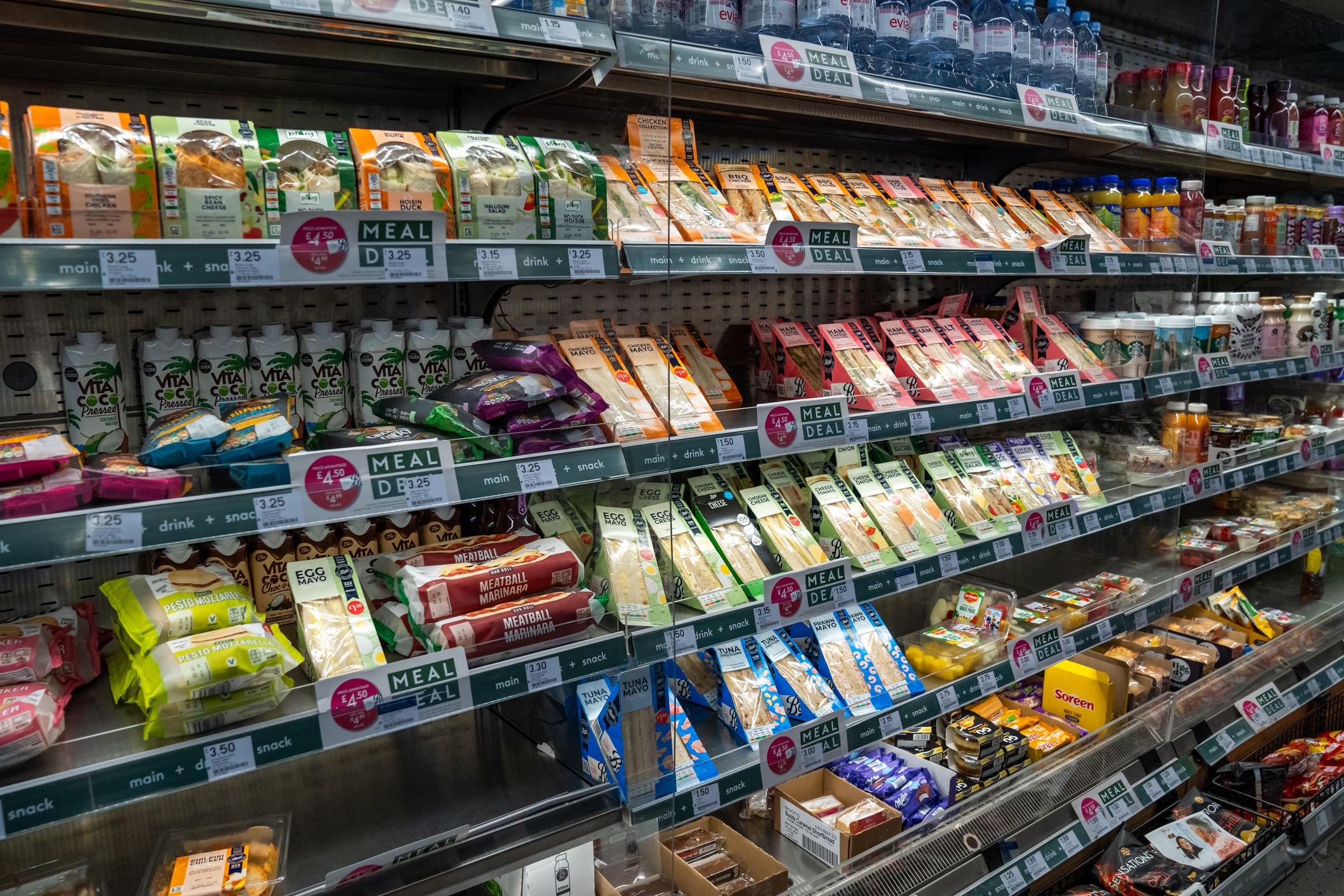The meal deal is a banal but beloved fixture of life in the UK. It promises harried office workers the chance to spend a few minutes of their lunch hour selecting their preferred combination of sandwich, snack and drink for a price that’s generally somewhere just above the £3 mark. You might have to scuttle back to your desk immediately afterwards to scoff your purchases while scrolling through emails, but during those brief moments in the meal deal aisle, the possibilities feel infinite. Now, however, this national institution is in crisis.
It might feel like it’s been around forever, but the meal deal is actually a pretty modern invention. Boots was the first to introduce the concept of the sandwich-drink-snack combo to the British high street back in 1999, initially rolling out the offer as a trial in just 16 stores around the country, priced at £2.50. Where the pharmacy went, supermarkets followed, and over the next few years, all the big hitters started to roll out their own versions.
Slightly naff, perennially underwhelming but still somehow appealing, the meal deal has all the requisite qualities of an unlikely British icon. Tourists are almost universally baffled by it (in fact, the whole setup is probably anathema to the various European nations that tend to elevate lunch to an art form, rather than squeezing it in al desko). There have been plenty of Facebook groups and Instagram accounts dedicated to the sport of “rating” the food combinations of others. Dry-looking ham sandwich with a bottle of water and a packet of ready salted crisps? Prepare to have your midday meal eviscerated.
In fact, judging other people based on their meal deal selection is practically a national hobby at this point. Even if you’re not quite brazen enough to voice your opinion on social media, you’ve probably silently made sweeping assumptions about the person sitting next to you on a train journey, based on their purchase of an egg mayo sandwich, a packet of cocktail sausages and a Monster energy drink at 9.30am. Somehow, the choice of three lunch items feels like a snapshot into the psyche; you can probably extrapolate the shopper’s entire life story based on them. Chicken salad, protein bar and a Huel? I’m going to hazard a guess that you’re a highly optimised Diary of a CEO bro.
But whereas once this lunchtime failsafe felt like pretty solid value, the past few years have seen the prices sneak up steadily. What used to seem like a bargain is starting to seem like more of a luxury. Take Tesco’s offering, for example. The price of a meal deal at the supermarket chain remained steadfast at £3 from 2012 to 2022. Then, in February 2022, as the cost of living crisis kicked in, Tesco hiked the cost up to £3.50 for shoppers without a loyalty card. A few months later, in October, even clubcard holders had to take a hit, when the brand announced that members would now pay £3.40, and non-members would pay £3.90.
Since then, the cost has continued to creep up, and earlier this week, Tesco announced its third increase since 2022. Meal deals will now cost £3.85 for Clubcard holders, and £4.25 for those without. Naturally, the British public has dealt with this blow in a typically proportionate and restrained manner: search the phrase “Tesco meal deal” on X (Twitter) and you’ll find a whole slew of posts bemoaning this development and generally mourning the decline of our nation. Is the meal deal still a “deal” at all, many of them ask? Food for thought indeed (Tesco, for their part, have said that the offer “remains great value”).

And Tesco aren’t the only one rolling out price rises either. Back in June, Sainsbury’s ramped up the cost of its meal deal from £3.75 to £3.95, after having previously hiked it by 25p in July 2024. It’s a far cry from the glory days of a decade ago, when you could sneak a posh Taste the Difference sandwich into your selection and still only pay £3 (in 2016, the supermarket removed these from the deal, to much consternation).
Somehow, the choice of three lunch items feels like a snapshot into the psyche
Once upon a time, the humble Freddo chocolate bar was Britain’s edible cost of living indicator. The little Cadbury’s frog famously cost just 10p when it was relaunched in the Nineties, and has steadily become more expensive since, with the price reaching 30p last year. But now, it seems like the meal deal might be just as good (or should that be just as depressing?) a yardstick.
These price hikes are taking place against the backdrop of food costs increasing across the board. Recent inflation figures from the Office for National Statistics show that the price of food and non-alcoholic drinks rose by 4.9 per cent in the year to July; this marked the fourth month in a row that inflation had risen for food and drink. And food prices had also increased by a staggering 37 per cent over the past five-year period.
The cost of food is impacted by a whole host of potential factors, from climate change impacting the harvest, to global events such as the war in Ukraine affecting supply chains, to the rise in employment costs (such as the increase in employers’ national insurance contributions and minimum wage).
And the outlook doesn’t look too great for the rest of the year: according to the BBC, the Bank of England expects food price inflation to reach 5.5 per cent by the end of 2025. The halcyon days of the bargain meal deal, then, have probably gone for good. After all, once prices have risen, they rarely tend to fall back down by much.
The only way to sweeten the deal ever so slightly? Gaming the system as systematically as possible, of course. And by that, I mean trying to mastermind the most expensive product combination possible next time you’re making your lunch selection, so that you’re getting the most for your money – even if it means leaving the shop clutching some absolutely unholy amalgamation. A tray of sushi, one of those luminous blue smoothies and a massive veggie sausage roll? Fancy coconut water, a triple-decker BLT and some hard-boiled eggs? Sure, why not. The flavour profile might be a little, erm, disconcerting, but at least you can try and kid yourself that you’re sticking it to our supermarket overlords.







